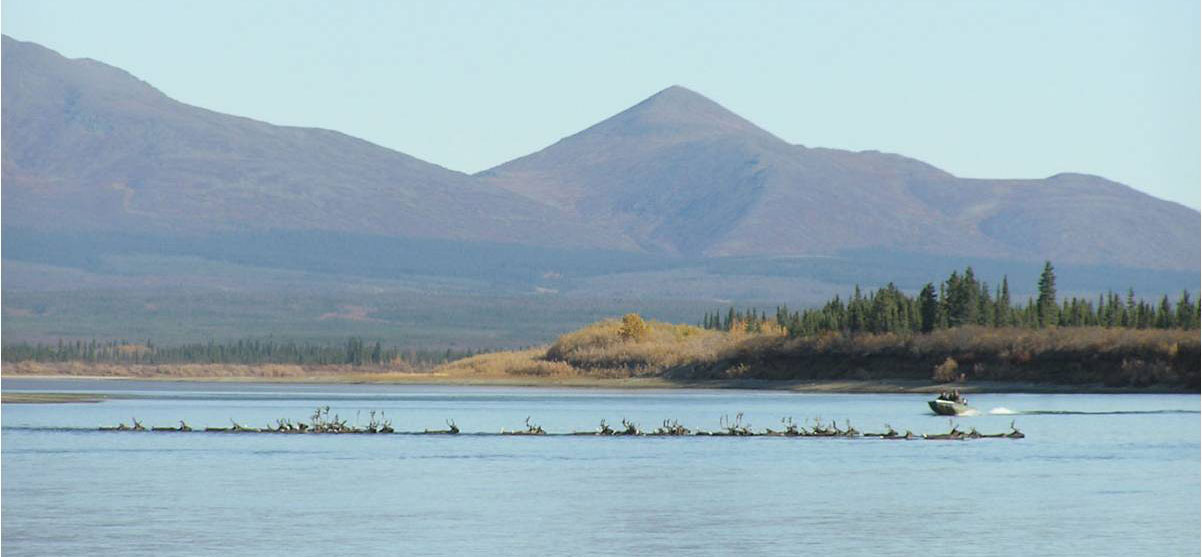
Waterskiing on the Kobuk River at Onion Portage, 1967.
Jon Hardes is an archaeologist with Western Arctic National Parklands in Kotzebue and specializes in zooarchaeology, the study of animal bones found in the archaeological record. Jon has provided the following introduction to the history and discoveries of the Onion Portage National Historic Landmark in Kobuk Valley National Park. Onion Portage is on the minds of many subsistence hunters in northwest Alaska now, as this has been an important place to hunt caribou for millennia. Sport hunting is not permitted within the National Park, but the history, wildlife, and scenery are enjoyed by several hundred Park visitors annually.

Map showing the Onion Portage area within Kobuk Valley National Park, Alaska.
The name “Onion Portage” comes from the Inupiaq word “Paatitaaq” meaning “wild onion” which refers to the great numbers of wild onions or chives that grow throughout the site. A convenient place of portage allowing for the avoidance of the oxbow accounts for the full name applied to the site (NPS 2004). Vast herds of caribou (Rangifer tarandus) have used this river crossing for thousands of years and continue to cross there today, making the location an ideal for “intercept hunting”This is a strategy in which a hunter uses the traditional migratory routes followed by these animals to their advantage.

Subsistence “intercept” hunting at Onion Portage in 2008. M. Johnson, NPS photo.
Drawn to the area because of the abundance of resources, the Kobuk River Valley and the Onion Portage site have been occupied by humans, at least seasonally, for more than 10,000 years. The broader attraction of the Onion Portage site to hunters as articulated by Douglas Anderson who continued work at the site following Giddings’ death:
“A sand knoll dominates the wooded landscape at the site. Hunters both ancient and modern have used this vantage as a lookout for the thousands of caribou that cross the river at Onion Portage, moving north in the spring and south in the fall. From the knoll the approaching animals can be seen soon enough for men to be stationed for the kill at points where the herd is likely to cross the river. The fishing at Onion Portage is also good; several species of salmon migrate upstream during the summer. The prized sheefish, which is scarce in other Alaska rivers, is also caught by the local Eskimos.” (Anderson 1968: 24, 27)

The Giddings’ excavation site in 1967. NPS photo.
Between 1940 and 1964 Archeology Professor J. Lewis Giddings, with the help of local workers, conducted archaeological investigations in the Kobuk River Valley that resulted in his deep excavations (over 10 feet in places) at the Onion Portage site beginning in 1961. His reexamination of the Onion Portage site in 1961 led to the identification of multiple stratified occupational layers. These excavations yielded thousands of artifacts made of wood, bone and stone. Types of artifacts include pottery, spear and arrow points, fishhooks, arrow shaft abraders, hide scrapers, drills and fishnet sinkers. Data collected from these excavations provided a foundation for archaeological interpretations of the entire region.

The “stratified occupational layers” identified by Dr. J. Lewis Giddings’ excavations. Doug Anderson photo.
Local Inupiaq resident Nelson Greist constructed a cabin for Giddings in 1964. The cabin has become a shrine to the archeological community, to Giddings and his work, and to the significance of the Onion Portage site as one of the best known places of continuous human occupation in Arctic America (NPS 2004). Today, the National Park Service owns the Giddings’ cabin and surrounding 5-acres. The Onion Portage Archeological District was declared a National Historic Landmark on June 20, 1972 and listed on the National Register of Historic Places. The district contains twelve Native allotments and a total of eight archaeological sites. The area encompasses just under 18,000 acres.

Construction of the Giddings Cabin. NPS photo.
Note: Much of the preceding information is taken directly from the National Park Service’s Cultural Landscape Inventory for Onion Portage (NPS 2004).
References cited:
Anderson, Douglas D. 1968. A Stone Age at the Gateway to America. Scientific American 208:6.
National Park Service. 2004. Cultural Landscapes Inventory: Onion Portage Archaeological District, Kobuk Valley National Park. Anchorage, AK: National Park Service.
Tread lightly!
The Onion Portage National Historic Landmark is a special resource for the Inupiaq people of northwest Alaska, archaeologists, and future generations. Though the Giddings Cabin is not available for public use, please take care when visiting the area by respecting the activities of subsistence hunters, avoiding private lands and allotments if you do not have permission, practicing Leave No Trace backcountry ethics, and leaving artifacts where they lie.

